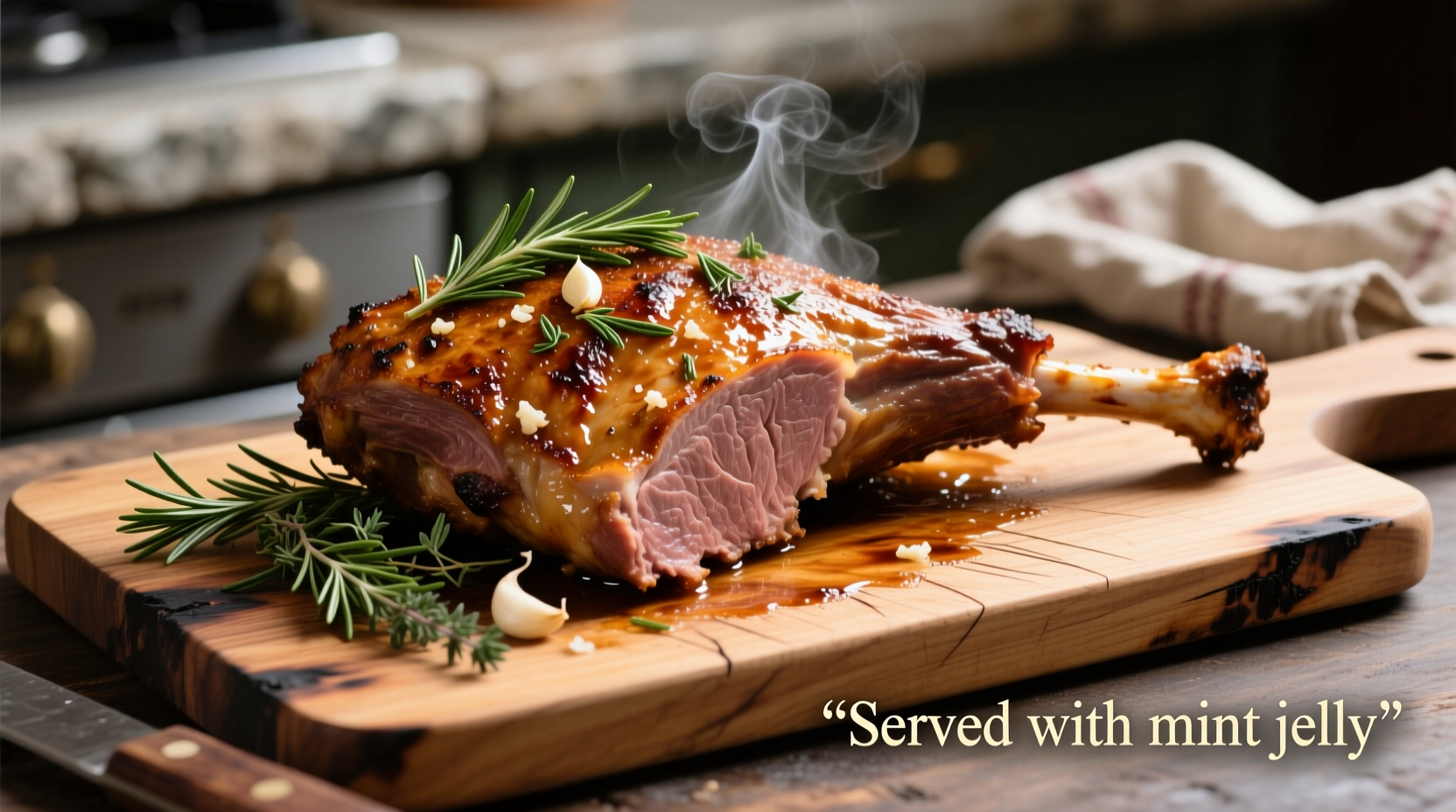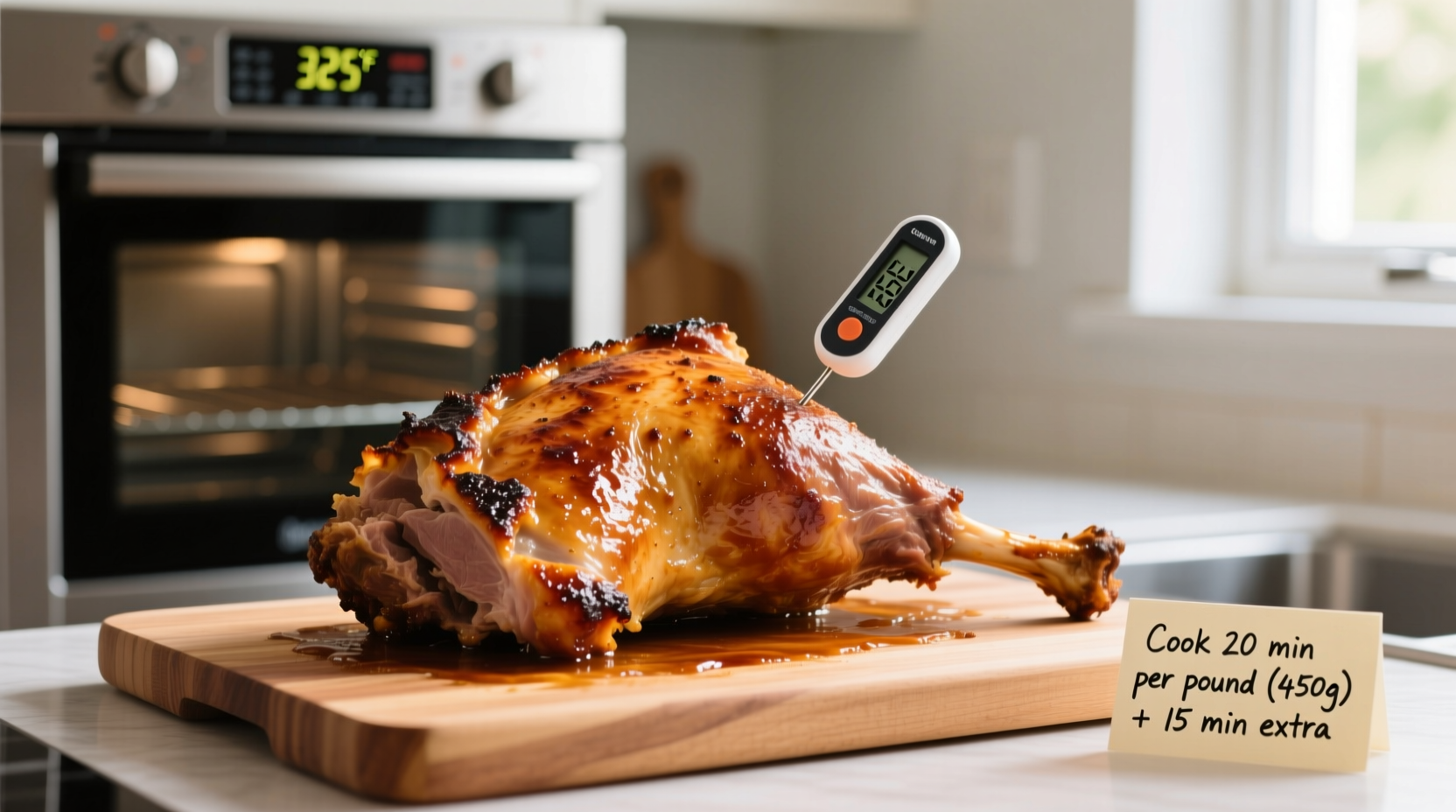The Complete Guide to Perfectly Cooked Leg of Lamb
Nothing impresses guests quite like a perfectly roasted leg of lamb, but getting the timing right can be challenging. Many home cooks struggle with undercooked or dried-out meat simply because they rely on time estimates alone without considering critical variables. This guide provides precise cooking times based on weight, oven temperature, and desired doneness—plus the essential factors most guides overlook.
Your Cooking Time Framework
While "how long to cook leg of lamb" seems straightforward, the answer depends on several interconnected factors. The standard calculation provides a starting point, but understanding the variables ensures consistent success:
- Basic timing formula: 15-20 minutes per pound at 325°F (163°C)
- Internal temperature targets: 120-125°F (rare), 130-135°F (medium-rare), 140-145°F (medium)
- Resting time: Minimum 15-20 minutes before carving
| Doneness Level | Internal Temperature | Visual Characteristics | Recommended For |
|---|---|---|---|
| Rare | 120-125°F (49-52°C) | Bright red center, cool | Experienced lamb enthusiasts |
| Medium-rare | 130-135°F (54-57°C) | Pink center, warm | Most home cooks (ideal balance) |
| Medium | 140-145°F (60-63°C) | Light pink center | Those preferring less pink |
According to the USDA Food Safety and Inspection Service, lamb should reach a minimum internal temperature of 145°F (63°C) for safety, followed by a 3-minute rest period. However, professional chefs typically recommend lower temperatures for optimal texture and flavor retention in premium cuts like leg of lamb.
Four Critical Factors That Change Your Cooking Time
Bone-In vs. Boneless: The 15% Rule
Bone-in legs require approximately 15% more cooking time than boneless preparations. The bone acts as a heat conductor, slowing the cooking process in the surrounding meat. This explains why many home cooks end up with unevenly cooked lamb—they apply the same timing to both preparations.
Starting Temperature Matters More Than You Think
Removing your lamb from the refrigerator 60-90 minutes before cooking brings it closer to room temperature, reducing cooking time by 10-15%. A cold roast placed directly in the oven creates significant temperature gradients, leading to overcooked exterior and undercooked interior. This principle is well-documented in America's Test Kitchen's meat roasting research.
Altitude Adjustments: The High-Elevation Factor
If you live at 3,000+ feet elevation, increase cooking time by 5-10%. Water boils at lower temperatures at higher altitudes, affecting how heat transfers through meat. This context boundary often gets overlooked in standard cooking guides but significantly impacts results for mountain residents.
The Temperature Timeline: What Actually Happens Inside
Understanding the internal temperature progression prevents guesswork:
- 0-110°F: Meat is absorbing heat, proteins beginning to denature
- 110-125°F: Collagen starts melting, juices begin forming
- 125-135°F: Optimal medium-rare range, maximum juiciness
- 135-145°F: Meat becomes progressively firmer, pink color fades
- 145+°F: Significant moisture loss, texture becomes dry

Your Step-by-Step Cooking Process
Preparation Phase (30 Minutes Before Cooking)
Pat the lamb completely dry with paper towels—this critical step creates better browning. Score the fat cap in a diamond pattern and rub with olive oil, salt, pepper, and your chosen herbs. Let sit at room temperature for optimal heat distribution.
Cooking Phase: The Two-Stage Method
For best results, use a two-stage cooking approach:
- Initial high heat (450°F/232°C) for 15 minutes: Creates a beautiful crust and seals in juices
- Reduce to 325°F (163°C) for remaining time: Ensures even cooking without over-browning
Insert an instant-read thermometer into the thickest part (avoiding bone) when you estimate 20-30 minutes remain. Check every 10 minutes as you approach target temperature.
Resting Phase: The Non-Negotiable Step
Rest your lamb for 15-20 minutes tented with foil. During this time, internal temperature will rise 5-10°F (carryover cooking), and juices redistribute throughout the meat. Skipping this step causes precious juices to spill out when carving, resulting in dry meat.
Troubleshooting Common Issues
"My lamb is undercooked but the time is up!"
Return to oven and check every 5 minutes. An oven thermometer can verify your oven's actual temperature—many home ovens run cooler than indicated, extending cooking times.
"The outside is perfect but inside is raw"
This indicates your oven temperature was too high. For future roasts, reduce initial searing temperature to 400°F (204°C) and extend the lower-temperature phase.
"My lamb turned out dry"
Likely causes: overcooking by just 5-10°F, skipping the resting phase, or using too high a temperature throughout. For next time, pull the roast 5°F below target temperature and ensure proper resting.
Pro Tips for Consistent Success
- Use a dedicated meat thermometer—don't rely on pop-up timers or visual cues alone
- Place lamb on a rack in a roasting pan to allow heat circulation
- For herb-infused flavor, create small slits and insert rosemary or thyme sprigs
- Calculate cooking time based on the actual weight, not package labeling
- Let leftovers rest covered before reheating to preserve moisture
Frequently Asked Questions
How long to cook a 6 lb leg of lamb at 325°F?
A 6 lb bone-in leg of lamb requires approximately 2 hours at 325°F (120 minutes at 20 minutes per pound). Check internal temperature starting at 1 hour 45 minutes—remove at 130-135°F for medium-rare, then rest 15-20 minutes.
Should I cover leg of lamb while roasting?
No, leg of lamb should roast uncovered to allow proper browning and crust formation. Covering traps steam, preventing the desirable caramelized exterior. Only tent with foil during the resting period after removal from the oven.
Can I cook leg of lamb at 350°F instead of 325°F?
Yes, but reduce cooking time by approximately 10-15%. At 350°F, cook for about 18 minutes per pound for bone-in lamb. Higher temperatures increase the risk of uneven cooking, so monitor internal temperature carefully starting 20 minutes earlier than standard timing.
Why is my leg of lamb tough despite proper cooking time?
Toughness usually indicates either undercooking (collagen hasn't properly melted) or overcooking (muscle fibers tightened excessively). For tougher results, try slow-roasting at 275°F (135°C) for 4-5 hours, which allows collagen to fully convert to gelatin without drying the meat.
How do I know when leg of lamb is done without a thermometer?
Without a thermometer, use the touch test: press the meat gently. Rare feels like the base of your thumb when hand is relaxed; medium-rare resembles thumb touching index finger; medium feels like thumb touching middle finger. However, a thermometer remains the only reliable method for precise doneness.











 浙公网安备
33010002000092号
浙公网安备
33010002000092号 浙B2-20120091-4
浙B2-20120091-4